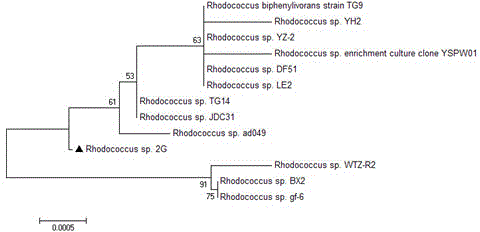Rhodococcus sp. 2G used for simultaneous degradation of plurality of phthalic acid esters
A phthalate and dimethyl phthalate technology, applied in the 2G field of Rhodococcus sp., can solve the problem that germplasm resources are rarely found, and achieve the expansion of strain resource library, Huge application prospects and strong adaptability
- Summary
- Abstract
- Description
- Claims
- Application Information
AI Technical Summary
Problems solved by technology
Method used
Image
Examples
Embodiment Construction
[0018] The content of the present invention is further described below with reference to the accompanying drawings and specific embodiments of the description, but should not be construed as a limitation of the present invention. Without deviating from the spirit and essence of the present invention, simple modifications or substitutions made to the methods, steps or conditions of the present invention all belong to the scope of the present invention; unless otherwise specified, the technical means used in the embodiments are those of ordinary skill in the art well-known conventional means.
[0019] In the embodiment of the present invention, DMP is the abbreviation of dimethyl phthalate, DEP is the abbreviation of diethyl phthalate, DB is the abbreviation of dibutyl phthalate, and DEHP is the abbreviation of diisophthalate. Abbreviation for octyl ester.
[0020] Example 1 PAEs Isolation and identification of highly efficient degrading bacteria
[0021] 1. Culture ...
PUM
 Login to View More
Login to View More Abstract
Description
Claims
Application Information
 Login to View More
Login to View More - R&D
- Intellectual Property
- Life Sciences
- Materials
- Tech Scout
- Unparalleled Data Quality
- Higher Quality Content
- 60% Fewer Hallucinations
Browse by: Latest US Patents, China's latest patents, Technical Efficacy Thesaurus, Application Domain, Technology Topic, Popular Technical Reports.
© 2025 PatSnap. All rights reserved.Legal|Privacy policy|Modern Slavery Act Transparency Statement|Sitemap|About US| Contact US: help@patsnap.com



